
The Dead Sea is a salt lake bordered by Jordan to the east and Israel and the West Bank to the west. It lies in the Jordan Rift Valley, and its main tributary is the Jordan River.
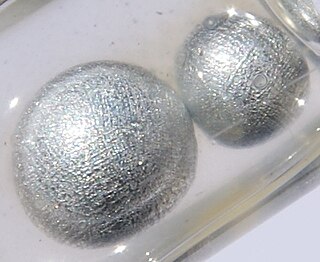
Potassium is a chemical element with the symbol K and atomic number 19. Potassium is a silvery-white metal that is soft enough to be cut with a knife with little force. Potassium metal reacts rapidly with atmospheric oxygen to form flaky white potassium peroxide in only seconds of exposure. It was first isolated from potash, the ashes of plants, from which its name derives. In the periodic table, potassium is one of the alkali metals, all of which have a single valence electron in the outer electron shell, that is easily removed to create an ion with a positive charge – a cation, that combines with anions to form salts. Potassium in nature occurs only in ionic salts. Elemental potassium reacts vigorously with water, generating sufficient heat to ignite hydrogen emitted in the reaction, and burning with a lilac-colored flame. It is found dissolved in sea water, and occurs in many minerals such as orthoclase, a common constituent of granites and other igneous rocks.

Potash includes various mined and manufactured salts that contain potassium in water-soluble form. The name derives from pot ash, which refers to plant ashes or wood ash soaked in water in a pot, which was the primary means of manufacturing the product before the Industrial Era. The word "potassium" is derived from "potash".

Sodium chloride, commonly known as salt, is an ionic compound with the chemical formula NaCl, representing a 1:1 ratio of sodium and chloride ions. With molar masses of 22.99 and 35.45 g/mol respectively, 100 g of NaCl contains 39.34 g Na and 60.66 g Cl. Sodium chloride is the salt most responsible for the salinity of seawater and of the extracellular fluid of many multicellular organisms. In its edible form of table salt, it is commonly used as a condiment and food preservative. Large quantities of sodium chloride are used in many industrial processes, and it is a major source of sodium and chlorine compounds used as feedstocks for further chemical syntheses. A second major application of sodium chloride is de-icing of roadways in sub-freezing weather.
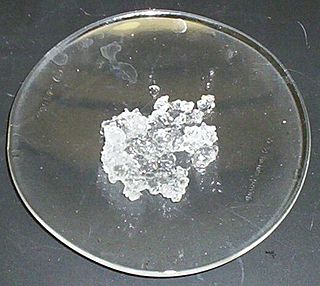
Magnesium chloride is the name for the chemical compound with the formula MgCl2 and its various hydrates MgCl2(H2O)x. Anhydrous MgCl2 contains 25.5% elemental magnesium by mass. These salts are typical ionic halides, being highly soluble in water. The hydrated magnesium chloride can be extracted from brine or sea water. In North America, magnesium chloride is produced primarily from Great Salt Lake brine. It is extracted in a similar process from the Dead Sea in the Jordan Valley. Magnesium chloride, as the natural mineral bischofite, is also extracted (by solution mining) out of ancient seabeds, for example, the Zechstein seabed in northwest Europe. Some magnesium chloride is made from solar evaporation of seawater. Anhydrous magnesium chloride is the principal precursor to magnesium metal, which is produced on a large scale. Hydrated magnesium chloride is the form most readily available.

The Eder[ˈeːdɐ] is a 177-kilometre (110 mi)-long major river in Germany that begins in eastern North Rhine-Westphalia and passes in to Hesse, where it empties into the River Fulda.

Salty liquorice, salmiak liquorice or salmiac liquorice, is a variety of liquorice flavoured with the ingredient "salmiak salt", and is a common confection found in the Nordic countries, Benelux, and northern Germany. Salmiak salt gives salty liquorice an astringent, salty taste, akin to that of tannins—a characteristic of red wines, which adds bitterness and astringency to the flavour. Consuming salmiak liquorice can stimulate either a savoury or non-savoury palate and response. Anise oil can also be an additional main ingredient in salty liquorice. Extra salty liquorice is additionally coated with salmiak salt or salmiak powder, or sometimes table salt.

The German Patent and Trade Mark Office is the German national patent office, with headquarters in Munich, and offices in Berlin and Jena. In 2006 it employed 2556 people, of which about 700 were patent examiners.
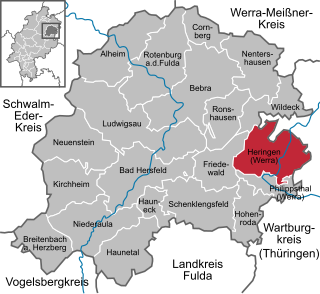
Heringen (Werra) is a small town in Hersfeld-Rotenburg district in eastern Hesse, Germany lying right at the boundary with Thuringia.

A spoil tip is a pile built of accumulated spoil – waste material removed during mining. These waste materials are typically composed of shale, as well as smaller quantities of carboniferous sandstone and other residues. Spoil tips are not formed of slag, but in some areas, such as England and Wales, they are referred to as slag heaps. In Scotland the word bing is used.

Philippsthal (Werra) is a market community in Hersfeld-Rotenburg district in eastern Hesse, Germany, right at the boundary with Thuringia.

Wintershall Holding GmbH, based in Kassel, was Germany's largest crude oil and natural gas producer. It was a wholly owned subsidiary of BASF. The company was active in oil and gas exploration and production with operations in Europe, North Africa, South America as well as Russia and the Middle East region. Wintershall employed more than 2,000 people worldwide. In the 2018 financial year the company produced around 171 million barrels of oil equivalent (boe) of oil and gas. Revenues amounted to 4.09 billion euros.
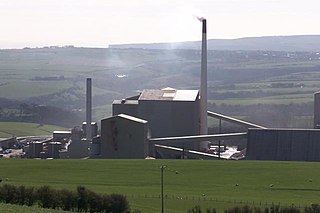
Boulby Mine is a 200-hectare (490-acre) site located just south-east of the village of Boulby, on the north-east coast of the North York Moors in Loftus, North Yorkshire England. It is run by Cleveland Potash Limited, which is now a subsidiary of Israel Chemicals Ltd. (ICL).

The Asse II mine is a former salt mine used as a deep geological repository for radioactive waste in the Asse Mountains of Wolfenbüttel, Lower Saxony, Germany.

Chemische Fabrik Kalk (CFK) was a German chemicals company based in Kalk, a city district of Cologne. The company was founded in 1858 as Chemische Fabrik Vorster & Grüneberg, Cöln by Julius Vorster and Hermann Julius Grüneberg and was renamed to Chemische Fabrik Kalk GmbH in 1892. At times the company was the second-largest German producer of soda ash and was, with almost 2400 employees, one of the largest employers in Cologne. For decades the chimneys and the water tower of the factory dominated the skyline of Cologne-Kalk.

The Stone Bridge in Regensburg, Germany, is a 12th-century bridge across the Danube linking the Old Town with Stadtamhof. For more than 800 years, until the 1930s, it was the city's only bridge across the river. It is a masterwork of medieval construction and an emblem of the city.

The Salzungen Werra Upland is a natural region in Germany that forms part of the East Hesse Highlands in the German states of Hesse and Thuringia.
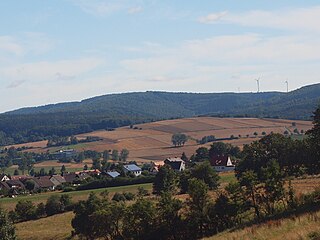
The Seulingswald is a hill range in the German Central Uplands which reaches heights of up to 480.3 m above sea level (NHN). It is part of the Fulda-Werra Uplands in the East Hesse Highlands within the Hessian county of Hersfeld-Rotenburg; small ridges extend into the Thuringian county of Wartburgkreis. It is a sandstone range and one of the largest contiguous woodland areas in Hesse.

The Hornungskuppe is a wooded hill, 439 m above sea level (NHN), in the Thuringian Zipfel on the border of Hesse and Thuringia in Germany. It is part of the natural region of the Seulingswald.

Landlocked Switzerland supports a small commercial fishing industry in its many large lakes. About 200 fishermen nationally ply them in small boats, supplemented by fish farmers who largely raise trout with some carp. The former catch primarily perch and whitefish, with pike, lake trout and Arctic char making up significant portions of the country's 12,000-tonne annual catch. Angling is also popular, while fish processing is marginal, largely limited to making fish oil for the country's drug industry.





















